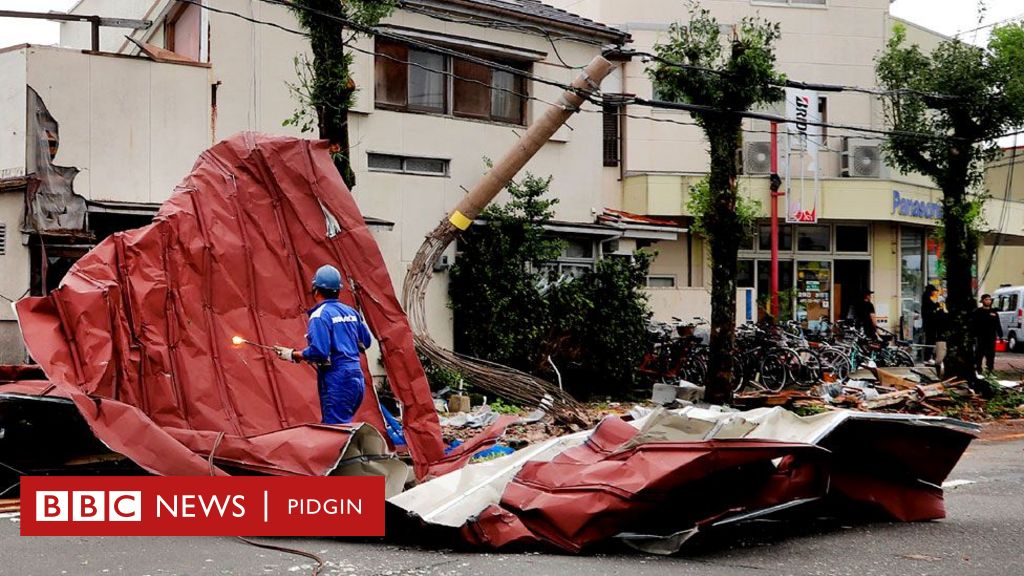Wia dis foto come from, Getty Images
- Author, Nick Marsh & Kelly Ng
- Role, BBC News
Japan don issue dia highest level alert give more dan five million pipo afta one of di strongest typhoons to ever happun in decades hit di kontri.
At least four pipo don die and more dan 90 wunjure afta Typhoon Shanshan land for di south-west part of di kontri.
Hundreds of thousands of pipo now no get access to electricity sake of di typhoon.
Authorities issue di level five order for some part of di southern island of Kyushu as dem tell residents to take immediate life-saving action and move go safer location or seek shelter for higher places for dia homes. In oda areas, dem don advise pipo to comot di area.
Shanshan bin land for Kagoshima prefecture, for di southern island of Kyushu, at around 08:00 local time on Thursday (23:00 GMT Wednesday), Japan Meteorological Agency (JMA) tok.
Afta e make di landfall, di typhoon don turn to serious tropical storm and e dey move towards di north-east, e dey cause heavy rainfall and don seriously scata transport services.
Di typhoon don leave behind plenty destruction as e start, many buildings don damage, windows break, trees uproot and cars somersault.
Late on Tuesday, three pipo from di same family – one couple wey dey dia 70s and one man for im 30s – bin die sake of landslide for central Japan even before di typhoon land.
Police confam di death of di fourth pesin on Thursday. Di 80-year-old man from Tokushima prefecture bin dey trapped afta di roof of one house collapse about 17:30 local time (08:30 GMT), according to Japan national broadcaster NHK.
Fire brigade bin rescue di man around 50 minutes afta di incident happun but e later die for hospital.
Di agency bin issue rare “special warning” for di most violent storms, as dem warn of landslides, flooding and large-scale damage.
High winds of up to 252 km/h (157mph) don dey reported on Kyushu.
Most of di evacuation orders na for di southern island of Kyushu, but some place for central Japan also receive di evacuation order.
Videos online show large trees wey di strong winds dey blow, how tiles from house remove, how things just dey fly for air as heavy rains fall for di island.
Major carmakers like Toyota and Nissan don shut down dia plants, dem say for di safety of employees as well as potential parts shortages wey di storm cause.
Map show predicted path of Shanshan

Shanshan bin land for Kagoshima prefecture, for southern island of Kyushu, at around 08:00 local time (23:00 GMT), Japan Meteorological Agency (JMA) tok.
Dem don cancel hundreds of flights to and from southern Japan, dem also suspend some high-speed train services.
JMA dey expect di storm to move across Japan ova di weekend before e reach di capital, Tokyo.
Dem don declare special typhoon warnings for Japan like di one dem issue for Shanshan, in case of extraordinarily powerful storms. T
Shanshan dey come in di wake of Typhoon Ampil wey happun earlier dis month, wey bin cause only minor injuries and damage but still disrupt hundreds of flights and trains.
Bifor dat, northern parts of Japan bin see record rainfall wen Tropical Storm Maria hit Honshu island.
Typhoons for di region don dey form closer to coastlines, e dey increase more rapidly and dey last longer for land sake of climate change, according to one study released last month.

Wia dis foto come from, Reuters
Wetin be typhoon?
Typhoons dey common in Japan, and dia season dey high during August and September.
According to Japan Meteorological Agency, 25 cyclones of tropical storm strength or higher dey recorded for di north-west Pacific in a typical year, of which an average of three go make landfall for Japan.
Some of these go dey strong enough to dey classified as typhoons – as e be wit di case wit Shanshan.
Typhoon na deep area of low pressure wey form from one organised cluster of thunderstorms ova warm tropical waters.
Fed by di warmth of di ocean, wit sea surface temperatures above 27C (81F), these weather systems fit strengthen rapidly to bring powerful winds, dangerous seas and flooding rain.
Typhoons na di same as hurricanes – di only difference na wia dem dey form. Hurricane na di term dem dey use for storms wey form for di Atlantic or eastern Pacific, whereas typhoon na term dem dey use for di north-west Pacific.

